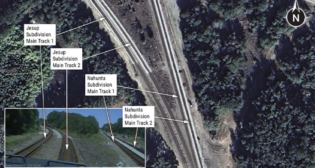
Trump wants to cut years off permitting process
Written by Mischa Wanek-Libman, Editor, Railway Track & Structures; and Engineering Editor, Railway AgePresident Donald Trump joined U.S. Department of Transportation (USDOT) Secretary Elaine Chao and other infrastructure stakeholders at USDOT headquarters to close out Infrastructure Week and push the regulatory reform element of his infrastructure plan.
“We are here today to focus on solving one of the biggest obstacles to creating this new and desperately needed infrastructure, and that is the painfully slow, costly and time-consuming process of getting permits and approvals to build,” said Trump. “It is a long, slow, unnecessarily burdensome process.”
To move the planned reform along, USDOT published a notice in the Federal Register on June 8 requesting infrastructure stakeholders, as well as the public, “to identify non-statutory requirements that the department imposes and that should be removed or revised.”
USDOT will accept input on how to improve the permitting process through July 24, 2017, and will use the input to “identify and reduce unnecessary regulatory obstacles that too often stand in the way of completing important infrastructure projects across the nation.”
During his speech, Trump noted that “it can take 10 years and far more than that just to get the approvals and permits needed to build a major infrastructure project.” The White House blog on June 8 published material that said the infrastructure plan “aims to dramatically reduce permitting time for these infrastructure projects from 10 years to two years.”
Should the Administration’s permitting reform produce its intended results, projects would move through the EIS process three to eight years faster, Trump said. “This massive permit reform—and that’s what it is; it’s a permit reform—doesn’t sound glamorous,” he said. “But it’s so important … it’s only the first step in renewing America’s roads, rails, runways and rivers.”
However, According to National Association of Environmental Professionals (NAEP), which tracks the state of the National Environmental Policy Act (NEPA) process, the average permitting process time is far less than 10 years.
NAEP’s most recent NEPA Report from 2015 says the average time to prepare an Environmental Impact Statement (EIA), from Notice of Intent to Final EIS, was five years, with 16% of EISs prepared in two years or less. This is an increase from the 2014 NEPA Report where the average EIS time frame was 4.7 years and nearly 36% of EISs were prepared in two years or less.
 Adds Railway Age Capitol Hill Contributing Editor Frank Wilner, “The curious thing about the Trump infrastructure plan is that his complaint about permitting delays is largely specious. The reports I have seen indicate that perhaps as few as 4% of projects are so delayed, and the reasons for such delays are material and not simply bureaucratic. But the reaction from the Senate, whose Majority Leader is Mitch McConnell (R-Ky.), husband of USDOT Secretary Elaine Chao, is that Trump’s plan is ‘dead on arrival.’”
Adds Railway Age Capitol Hill Contributing Editor Frank Wilner, “The curious thing about the Trump infrastructure plan is that his complaint about permitting delays is largely specious. The reports I have seen indicate that perhaps as few as 4% of projects are so delayed, and the reasons for such delays are material and not simply bureaucratic. But the reaction from the Senate, whose Majority Leader is Mitch McConnell (R-Ky.), husband of USDOT Secretary Elaine Chao, is that Trump’s plan is ‘dead on arrival.’”
This situation is oddly familiar, in that it’s similar to that of former Senator Bob Dole and his wife Elizabeth Dole, who was Transportation Secretary under President Ronald Reagan while her husband was chair of the Senate Finance Committee in the 1980s. Dole, recalls Wilner, “was trashing Amtrak while Elizabeth was supporting it.”
An excerpt from Wilner’s book, Amtrak: Past, Present and Future:
“Sen Robert Dole (R-Kans.) added levity to the debate [on Amtrak subsidies] after his wife, Elizabeth, became President Reagan’s transportation secretary. ‘My wife wakes up during the night saying, ‘Amtrak, Amtrak.’ That’s her private view. Publicly, she wants to eliminate it.’”



